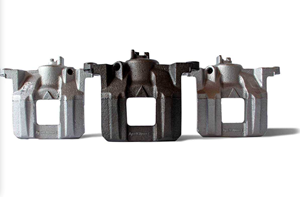Avoiding Adhesion Failure Due to Paraffin
For plating applicators, paraffin residue can cause poor adhesion, delayed blistering or other poor-quality performance of the plated deposit, including poor corrosion resistance. Coventya director of business development Greg Terrell explains how to remove paraffin-based lubricants prior to plating.
Share
Q: We recently ran into a rash of adhesion failures on our rack alkaline zinc line, and we traced it back to a new job. We obtained an SDS on the lubricant used and a main ingredient was a paraffin. What is the best way to remove this?
First, why is paraffin a good additive? The metal-forming industry focuses on lubricants that extend the life of the tooling that forms the product. One of the most effective additives to metalworking fluids that enables the presses, tools and dies to provide this characteristic is paraffin.
The paraffin, commonly referred to as wax, is used as a base. The wax helps lubricant to stick to parts during any metal-forming operation. The paraffin clings to the metal and forms a film of lubricity at the cutting edge. The film prevents the metal from weakening at the cutting edge and helps ensure that a quality end-product is manufactured.
Sometimes, manufacturing companies change these lubricants internally for improved performance or reduced pricing and may or may not know they contain paraffin or waxes.
Often, a part type can be fabricated by two different manufacturers, and one may be using paraffinic lubricants while the other may not (which might explain some inconsistent reject rates for the plating applicator). If the parts are in storage for a longer period of time prior to plating, the paraffin can be more difficult to remove in any plating process.
Once the paraffin is applied and has served its purpose, it needs to be effectively removed from surfaces to avoid any interference with other post-part manufacturing processing. In this case, the processing would be electroplating to provide corrosion protection and a nice visual appearance for the consumer.
For plating applicators, the paraffin residue or film causes poor adhesion, delayed blistering or other poor-quality performance with the plated deposit, including poor corrosion resistance.
How do we remove these types of soils effectively?
The classic way to remove paraffinic (wax-based) oils is to maintain the alkaline soak cleaner stage at a temperature that is above the melting point of the wax. This is usually between 160 and 180º F. This is a good tactic, as it is a successful way to “melt” the wax off the part surface; however, any cleaner film left on the parts will release the wax in the subsequent water rinsing stages due to the inherent lower temperatures of the rinses. This causes at least two problems: wax will redeposit on the parts, especially when acid activation is next in the process, and the paraffin will also get dragged down the process line over time.
Alkaline cleaner formulations typically used by plating plants are water-based. Traditionally, they have formula constituents that allow for three types of cleaning action:
- Saponification – Oils and fatty acids are chemically converted into soaps.
- Detergency – Surfactants (wetting agents) reduce the interfacial tension between the substrate and surface contaminants, enabling cleaning solutions to penetrate and displace the oils from the surface that is being cleaned.
- Emulsification – The suspension of particles and oils in the aqueous cleaner phase through the use of blends of surfactants.
Waxes, unfortunately, are not removed from surfaces effectively by any of these means, so an important fourth cleaning method called chemical dissolution is important for removing paraffin residues.
A popular principle of chemistry for predicting solubility, long known by all chemistry students, is “like dissolves like.” This statement indicates that a solute will dissolve best in a solvent that has a similar chemical structure to itself. The similarities, in this case, have to do with the types of chemical bonds that hold a compound together.
Broadly speaking, the chemical bonds can be either ionic or covalent. Crystalline solids are held together by the attraction of two oppositely charged ions (ionic or polar bonding). Another type of bond, the covalent bond, is formed by a shared pair of electrons (nonpolar bonding). There are other in-between cases where the electron sharing is not equal, called polar covalent bonds, but those are beyond the scope of this discussion.
In terms of solubility, nonpolar (covalent) solutes dissolve best in nonpolar solvents. So salts and other crystalline compounds, which are quite polar, dissolve well in water, which is also polar.
Because wax residues are highly nonpolar in nature, they will only dissolve in nonpolar solvents, such as toluene or benzene or that type of chemical. Of course, these specific solvents are not viable in many plating shops today.
“Like” liquids should mix together and blend while “unlike” liquids won’t, and will separate out. This is similar to what happens when oil and water are mixed — they will quickly separate into distinct layers.
Today, many commercial solvents are mixes of a variety of nonpolar liquids, rather than being a single solvent, and most of them will dissolve wax and similar substances. They vary in toxicity, carcinogenicity, flammability and density, but nonpolar solvent-type chemistries, as can be expected by their chemical similarities, will mix together pretty well.
Alcohols (ethanol, methanol and so on) fall somewhere towards the middle of the polarity spectrum. They will mix with both polar substances (e.g. scotch and water) and with nonpolar ones (for example, perfumes, which are mixes of essential oils and alcohol). As a result, many types of alcohol chemistries can be used to effectively and safely remove wax residues.
So, what does all this chemical theory do to overcome rejects if a paraffin soil is determined to be the cause of failure?
Well, simply put, there are types of water-soluble solvents that are available in cleaner additive packages which help water-based cleaning systems with wax removal. These additives are typically added to existing soak cleaner tanks in low concentrations and are very effective at dissolving the wax.
Related Content
How to Choose Between Sulfate and Chloride-Based Trivalent Chromium
There are several factors to consider when choosing between sulfate and chloride-based baths for trivalent chromium plating. Mark Schario of Columbia Chemical discusses the differences and what platers should keep in mind when evaluating options.
Read MoreProducts Finishing Reveals 2023 Qualifying Top Shops
Each year PF conducts its Top Shops Benchmarking Survey, offering shops a tool to better understand their overall performance in the industry. The program also recognizes shops that meet a set of criteria to qualify as Top Shops.
Read MoreRead Next
Ask The Expert: Clean Paraffin Wax Die Lube
Q. We are a general purpose coating house. Our cleaning line consists of an alkaline cleaner, city water rinse, iron phosphate, sealer, RO rinse then RO halo.
Read More
.jpg;maxWidth=150;quality=70)



















.jpg;maxWidth=400;quality=70)
